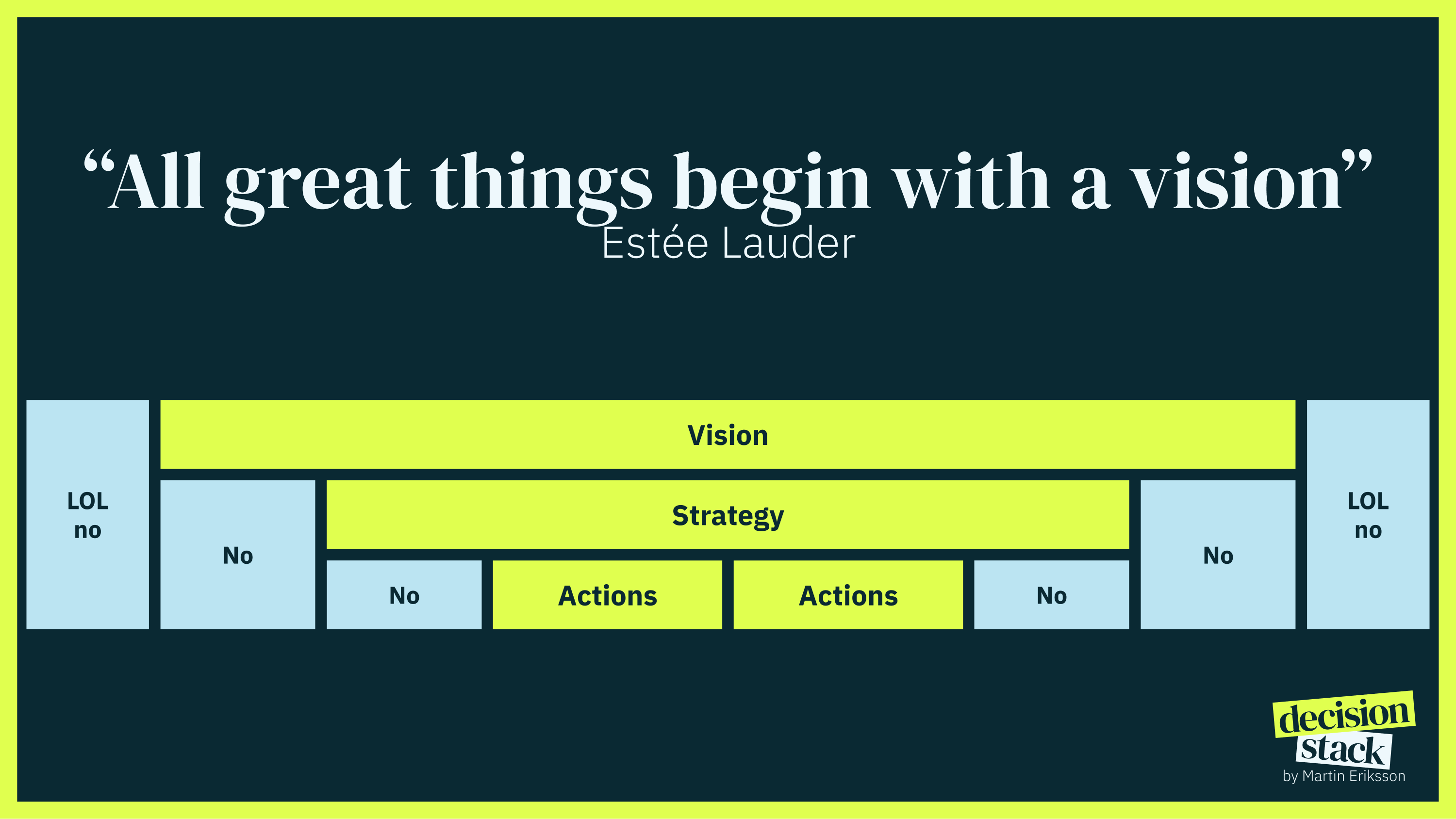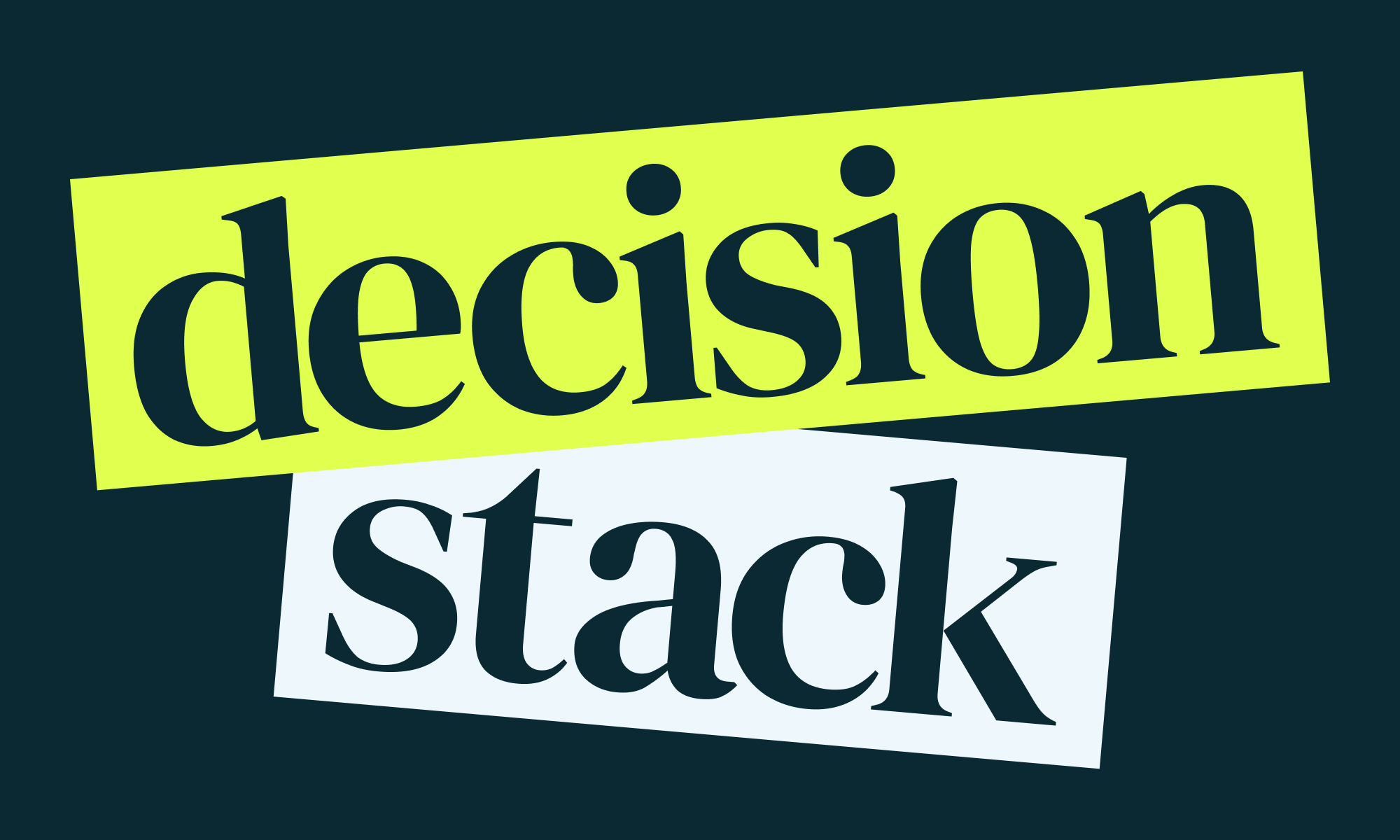Why your (company) vision is blurry
Does your company vision help you make decisions? Most don’t. Here is why a clear ambitious vision is so important - and how you can create one.

Does your company vision help you make decisions? Most don’t. There’s a reason everyone groans a little inside when they’re invited to a company vision session. Too many visions are just fluffy nonsense that don’t actually help you in your day to day work, and so just end up in a shiny powerpoint at the end of a long day of brainstorming, never to be seen again.
“If you want to build a ship, don’t drum up the men to gather wood, divide the work, and give orders. Instead, teach them to yearn for the vast and endless sea.” - Antoine de Saint-Exupéry
Why (most) company visions suck
Vision statements usually fall into three buckets:
1) “To be the (leading/best) (provider/supplier) of (customer focused/market driven) (solutions/products/service)” There is no one size fits all vision, and there’s certainly no fill-in-the-blanks madlibs template you can just fill in. The real problem with this sort of vision though, is that it doesn’t talk about your customer at all - nor does it define what “leading/best” means.
2) “Fluffy clouds and sunshine” at the other end of the spectrum you get the kind of vision statement that is so aspirational and fluffy it makes you feel good but doesn’t actually say anything about what you’re doing or for who. These are so general that they could describe any company out there and don’t help define you nor provide direction for the decisions you and your team needs to make every day.
3) Actually helpful visions are a minority, but one of my favourites comes from Google (Search) who say their vision is “to organize the world’s information and make it universally accessible and useful.” It’s short, it’s focused, it’s aspirational, and it’s motivational. Is yours?
Why vision is important
A vision helps align your organisation around a common goal but also keeps them focused and motivated when everything goes wrong.
Vision is focus
“You've got to think about big things while you're doing small things, so that all the small things go in the right direction.” - Alvin Toffler
Vision is at the top of the Decision Stack because it’s the first decision you have to make. And that decision has to provide focus for everything that comes after it. A vision, as we’ll see below, talks about what problem you’re going to solve, who you’re solving it for, and what the world looks like once it’s solved. Done well, therefore, your vision becomes not just a rallying cry for your team but also a clear decision rubric that provides focus for every daily decision you and your team make.
Vision is motivation
“We need missionaries, not mercenaries” - John Doerr, Kleiner Perkins
What motivates you at work every day? It’s probably not just money (once you’re paid a decent market salary), nor is it performance. In his book The Surprising Truth About What Motivates Us Daniel Pink summarises decades of research into motivation for knowledge workers thus “To motivate employees beyond basic tasks, give them Autonomy, Mastery, and Purpose” and that last one is key - Purpose “is the desire to do something that has meaning and is important.”
This isn’t just a millennial conceit or a Type A vs Type B personality thing - you will be surprised just how much more motivated everyone on your team will be, and how much easier it is to attract great talent, when you know that your day to day work connects to something more aspirational and meaningful. And the vision doesn’t have to be world-changing, it’s enough to know that your work connects to real human outcomes for your customers.
Having a clear purpose that your organisation can connect with has real dividends too. In Built to Last: Successful Habits of Visionary Companies Jim Collins and Jerry Porras found that companies with a clear purpose and mission have outperformed the general stock market by a factor of 12 since 1925.
Vision is empowering
When John F Kennedy famously set out his vision "I believe that this nation should commit itself to achieving the goal, before this decade is out, of landing a man on the moon and returning him safely to the Earth." he didn't say NASA should launch 15 rockets, with a stretch goal of 20 - he set an ambitious vision and left it to the engineers to figure out how to achieve it.
Focusing an organisation on big ambitious outcomes rather than outputs is the best way to empower your teams - it sets a clear direction, defines what success looks like, but leaves lots of creativity in achieving that goal to the team.
Vision makes space for big bets
Management always tends towards the sure thing, managing costs, incremental change - especially in the current market. But that doesn't encourage the kind of big bets our organisations need to really unlock their potential.
A clear, ambitious vision can change the conversation from "how do we improve this KPI by 10%" to "what would have to be true to achieve this vision".
Story time
I’ve seen this myself throughout my career. Whenever I have had the opportunity to work for an organisation with a clear mission that is more than just “hit your targets” it’s always been more motivating to grind through the boring stuff because I knew it was in service of something more.
But nowhere was the value of a good vision more evident than when I co-founded my own business and led the vision and strategy work for over a decade. At Mind the Product we started with no clear vision other than “run a conference”, but once we sat down to discuss it we at first came up with a typically cookie-cutter (and thus terrible) vision: “To be the leading product community in the world”. We promptly forgot we’d had the discussion but that line appeared every once in a while on strategy decks and the like until we started hiring our team.
Our team (quite rightly) asked about our vision, why we were doing this, and how we would even define “leading”. So we sat down with the whole team to do one properly, and I remembered how bad the cookie cutter template was and threw it out the window. Instead we discussed what motivated us to start the community in the first place, why that mattered, what made us different, and what the world might look like thanks to our efforts. Our new vision became “to make product people more successful by coming together to further our craft”.
This vision might not be perfect but it perfectly encapsulates what Mind the Product was all about. It focused on who we were doing this for - product people. It defined what success looked like - product people being more successful. And it talked about what we do differently in service of that goal - bringing people together to talk about our craft.
You’ll notice it doesn’t say anything about community, content, conferences, meet-ups, training, or any of the other things we actually built. Which makes it focused, aspirational, but not prescriptive. This came in handy when a few years later the Covid pandemic hit and in-person events stopped - taking 95% of our revenue with it. With just a few weeks before we’d have to go out of business - as many other product conferences did - we were able to use that vision to stay focused on our goal while pivoting to new strategies like a membership/subscription model and online events.
The prescription
So what makes a good vision? As with most parts of the Decision Stack, there is no cookie cutter, fill in the blanks option here. And that is especially true for your vision - what encapsulates your vision for the future won’t work for anyone else. With that said, I think there are three key elements to a great vision - you probably won’t use all three but you need at least one:
1. Be Aspirational
"Don't be afraid to do something big."
- Daphne Koller, Co-founder of Coursera
I believe your vision should be so audacious, you may never achieve it in your lifetime. It’s the mark of a great organisation to be thinking farther than the founders’ lifespan. One of my favourite visions is for the charity Oxfam, who aim for “a world without poverty”. Now there is one I wish was achievable much sooner - but what an aspirational goal to come to work for every day!
2. Define what success looks like
“You’ve got to visualize where you’re headed and be very clear about it. Take a Polaroid picture of where you’re going to be in a few years.”
- Sara Blakely, founder of Spanx
Non-profit organisations tend to describe an ideal future while for-profit companies describe their place in an ideal future. Maybe it’s Oxfam’s “a world without poverty”, or maybe it’s Tesla’s “helping the world transition to sustainable energy”, but focusing on a problem and defining what solving it looks like can be really powerful.
3. Be clear who you are doing it for
“Company vision must be driven by the aspirations of it’s customers”
- Kōnosuke Matsushita, founder of Panasonic
Not all visions do this but I find the most galvanising visions tend to focus clearly on who they are doing it for. A great example is Nike, whose vision is to “Bring inspiration and innovation to every athlete* in the world. (*If you have a body, you are an athlete)”. I like that they call out athletes while also underlining that every one of us can be one. Humans are empaths, and helping us visualise the people we are doing this for humanises the vision and connects us to them.
Mission vs Vision
The textbooks and blogs out there will tell you that there is a big difference between your mission and your vision. Commonly, a mission is defined as what you are doing right now and a vision is where you are going, but the distinction isn’t always clear.
In a startup where you are going and what you are doing now are one and the same. You can’t say where you’re going without referencing where you are, so why separate the two? In this context it’s fine to just have a vision and then get stuck into your strategy of how to get there - especially since we all know they are both likely to change as you start talking to customers, building your first product, and learning just how wrong those initial ideas were.
As you get more established though, it can be useful to break out the mission from your vision - it helps to clarify and separate where you’re going (vision), what you are doing to get there (mission), and what you are doing right now (strategy).
But there’s no right or wrong here - as with every other step in the Decision Stack, what elements you use is up to you - if your vision is clear enough then jump into strategy. If it’s useful and clearer to break it out into a vision and mission, then by all means do so.
Leave room for flexibility
“We are stubborn on vision. We are flexible on details…”
- Jeff Bezos, founder of Amazon
The power of Mind the Product’s vision is that it didn’t get into the details. The best visions leave room for different strategies and actions to achieve that vision. Take Google’s “to organize the world's information and make it universally accessible and useful” - it doesn’t mention search engines, email, maps, cloud platforms, AI, or any of the myriad other things Google builds and sells to customers - but all of them fit into the pursuit of that vision.
Visions aren’t set in stone either - as your organisation grows you should revisit the vision to make sure it still makes sense and helps guide your Decision Stack. You can reverse engineer a vision to encompass your business but be careful not to go too broad. Especially in a corporate environment a broadening base of business units can often lead to the worst visions. Microsoft may be a case in point, as their vision “to enable people and businesses throughout the world to realize their full potential.” is so broad as to be basically meaningless.
Lights, Camera, Action
“Vision without execution is hallucination.”
- Thomas Edison
Now you’ve set the scene, and put your vision (and mission) in place, it’s time to move down the Decision Stack and decide how to put it into action.
And that starts with strategy.

